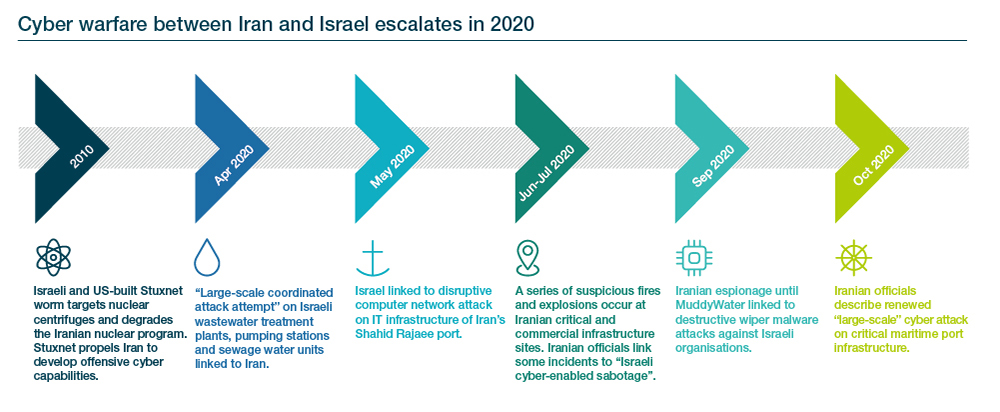Analysis
Geopolitics and cyber in 2021
- Global
- Cyber and Digital
Geopolitics and cyber in 2021
Geopolitical tensions are increasingly playing out in the technology and digital space, with impacts felt across geographies and sectors. At the same time, the rapid increase in connectivity triggered by COVID-19 has added further urgency to debates regarding reliance on foreign technology and its impact on national security. In this environment, organisations will have to maintain an understanding of the increasingly complex regulatory and cyber threat environments in which they operate.
Cyber priorities for the new US administration
The US presidential election was closely monitored for cyber-attacks, following multiple warnings about foreign interference. While serious interference did not occur on election day, that feeling of security was shattered in December when news broke of a large-scale supply chain attack by a Russian espionage unit that compromised the software of US-based IT company SolarWinds, and subsequently a significant number of US government agencies.
President Joe Biden has commissioned an intelligence assessment of cyber and other security issues with Russia, which is due for delivery in early 2021. This will likely trigger sanctions and indictments, potentially including detailed attribution of Russian cyber operations, as well as more computer network operations, information operations and active measures targeting Russia.
A reinvigorated NATO alliance under Biden will similarly raise the prospects for increased confrontation with Russia in cyberspace. In response, Moscow may direct its advanced persistent threat (APT) groups to demonstrate their technical capabilities and probe further weaknesses in European and US critical infrastructure systems.
Biden’s more multilateral approach will likely see the US return to the Iran nuclear deal, though his domestic focus on the pandemic makes a swift resumption of diplomatic talks unlikely. Amid prospects of sanctions relief, Iran is unlikely to conduct disruptive cyber operations against the US. Nevertheless, Tehran will almost certainly keep the pressure on US allies in the Middle East, and we expect the region to witness further significant disruptive cyber threats in 2021 as tensions persist.

The US likely faces an increasingly unpredictable North Korean regime, which has a track record of carrying out provocations early in the terms of US presidents. In 2021, Pyongyang could use its disruptive cyber capabilities against the US and its allies in Asia to improve its negotiating position. North Korea’s disruptive capabilities are not only a concern for the US, as past cyber-attacks by Pyongyang – notably 2017’s WCry – caused extensive damage and disruption to organisations globally.
US-China relationship remains key to both states’ strategies
The US and China will in 2021 double down on their pursuit of digital and technological supremacy to enable them to strategically shape global political, military, economic and ideological power in the 21st century (see RiskMap Top 5). As US-China tensions are unlikely to thaw under Biden, organisations will need to tread carefully between a myriad of emerging regulations, restrictions and competing technology standards.
The US will likely continue to adopt increasingly aggressive tactics to boost US competitiveness and to halt the export and transfer of US technology and personal data to adversary states, chiefly China. US efforts to stop the spread of Chinese digital technology will further validate Beijing’s perception that its dependence on foreign suppliers for core technologies constitutes a major threat. In response, China will begin implementing its ambitious China Standards 2035 initiative, designed to catch up with and overtake advanced Western economies through international standardisation on emerging technologies, networks and platforms.
While Washington and Beijing remain unlikely to disrupt each other’s critical infrastructure in the year ahead, we expect sophisticated APT units to attempt to pre-position on critical military and infrastructure systems to prepare for future tensions. China’s rapidly improving space capabilities and the growing mission profile of the US Space Force also presage espionage and disruptive cyber threats to satellite and telecommunications companies.
2021 will reinforce the notion that digital technologies are the main battleground for geopolitical dominance. States and organisations caught in this geopolitical battle will need to understand where the fault lines and key nuances in this competition lie to increase their own room for manoeuvre.
Middle powers caught in the crossfire
In 2020, we saw a diverse set of regional and international efforts to respond to the increasing politicisation and fragmentation of technology. From regulation of technology and critical services in the EU, to banning apps amid tensions between China and India, technology and digital services are key geopolitical battlegrounds – and not just for the world’s superpowers. Diverse regional and national responses in 2021 will have significant operational impacts on businesses.
In regions such as Europe and parts of Asia, governments are increasingly looking to align with like-minded states to retain a global voice on technology and digital regulation, while taking more forceful steps to protect critical technology assets and infrastructure. Elsewhere, such as in Latin America and Africa, states are taking a more pragmatic view, seeking to balance competing interests. Lower-capability cyber powers such as India, Vietnam, Turkey and others will likely focus on enhancing their defensive and offensive cyber capabilities.
Wherever we look, diverging positions and increasing fragmentation on data and technology will likely compound regulatory and compliance challenges for multinational companies in 2021. Meanwhile, the rapid adoption of digital solutions in 2020 has vastly increased the attack surface for cyber threat actors across the spectrum, and poses significant new challenges to both states and businesses.
The lack of global leadership and the politicisation of cyber security norms mean responses to cyber security threats will likely remain disjointed. Although national and regional efforts to build capacity have accelerated, the capability to meet these emerging challenges will likely vary significantly across countries and regions – leaving organisations the task of staying ahead of these accelerations and divergences.
